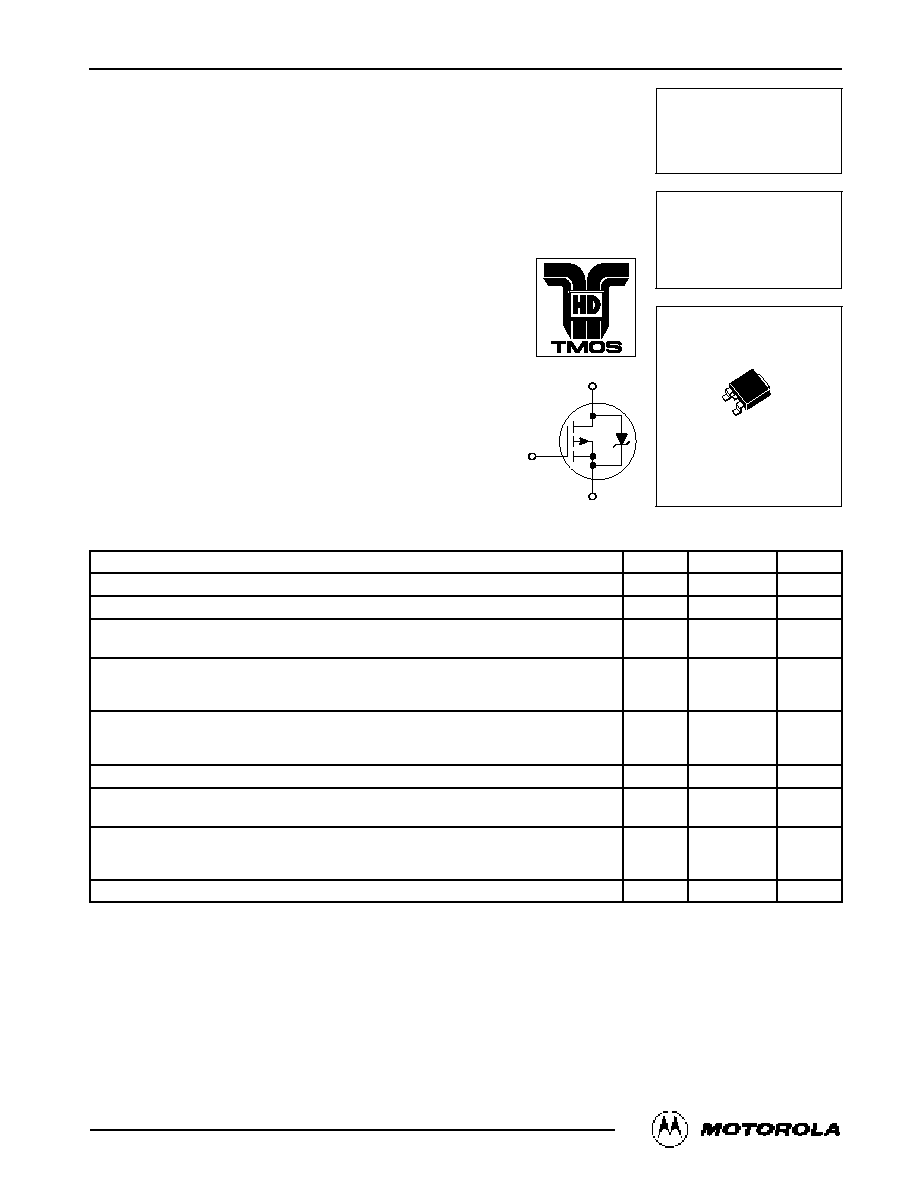
1
Motorola TMOS Power MOSFET Transistor Device Data
Designer's
TM
Data Sheet
HDTMOS E-FET
TM
High Density Power FET
DPAK for Surface Mount
P≠Channel Enhancement≠Mode Silicon Gate
This advanced high≠cell density HDTMOS E≠FET is designed to
withstand high energy in the avalanche and commutation modes.
The new energy efficient design also offers a drain≠to≠source
diode with a fast recovery time. Designed for low≠voltage,
high≠speed switching applications in power supplies, converters
and PWM motor controls, and other inductive loads. The avalanche
energy capability is specified to eliminate the guesswork in designs
where inductive loads are switched, and to offer additional safety
margin against unexpected voltage transients.
∑
Ultra Low RDS(on), High≠Cell Density, HDTMOS
∑
Diode is Characterized for Use in Bridge Circuits
∑
IDSS and VDS(on) Specified at Elevated Temperature
∑
Avalanche Energy Specified
∑
Surface Mount Package Available in 16 mm, 13≠inch/2500
Unit, Tape & Reel, Add T4 Suffix to Part Number
MAXIMUM RATINGS
(TC = 25
∞
C unless otherwise noted)
Rating
Symbol
Value
Unit
Drain≠Source Voltage
VDSS
60
Vdc
Drain≠Gate Voltage (RGS = 1.0 M
)
VDGR
60
Vdc
Gate≠Source Voltage -- Continuous
Gate≠Source Voltage
-- Non≠Repetitive (tp
10 ms)
VGS
VGSM
±
15
±
20
Vdc
Vpk
Drain Current -- Continuous
Drain Current
-- Continuous @ 100
∞
C
Drain Current
-- Single Pulse (tp
10
µ
s)
ID
ID
IDM
15
9.0
45
Adc
Apk
Total Power Dissipation
Derate above 25
∞
C
Total Power Dissipation @ TC = 25
∞
C (1)
PD
72
0.58
1.75
Watts
W/
∞
C
Watts
Operating and Storage Temperature Range
TJ, Tstg
≠ 55 to 150
∞
C
Single Pulse Drain≠to≠Source Avalanche Energy -- Starting TJ = 25
∞
C
(VDD = 25 Vdc, VGS = 5.0 Vdc, IL = 15 Apk, L = 2.7 mH, RG = 25
)
EAS
300
mJ
Thermal Resistance -- Junction to Case
Thermal Resistance
-- Junction to Ambient
Thermal Resistance
-- Junction to Ambient (1)
R
JC
R
JA
R
JA
1.73
100
71.4
∞
C/W
Maximum Temperature for Soldering Purposes, 1/8
from case for 10 seconds
TL
260
∞
C
(1) When surface mounted to an FR4 board using the minimum recommended pad size.
Designer's Data for "Worst Case" Conditions -- The Designer's Data Sheet permits the design of most circuits entirely from the information presented. SOA Limit
curves -- representing boundaries on device characteristics -- are given to facilitate "worst case" design.
Designer's, E≠FET and HDTMOS are trademarks of Motorola Inc.
TMOS is a registered trademark of Motorola Inc.
Thermal Clad is a trademark of the Bergquist Company.
Preferred devices are Motorola recommended choices for future use and best overall value.
REV 1
Order this document
by MTD20P06HDL/D
MOTOROLA
SEMICONDUCTOR TECHNICAL DATA
©
Motorola, Inc. 1995
D
S
G
MTD20P06HDL
TMOS POWER FET
LOGIC LEVEL
15 AMPERES
60 VOLTS
RDS(on) = 175 M
Motorola Preferred Device
TM
CASE 369A≠13, Style 2
DPAK

MTD20P06HDL
2
Motorola TMOS Power MOSFET Transistor Device Data
ELECTRICAL CHARACTERISTICS
(TJ = 25
∞
C unless otherwise noted)
Characteristic
Symbol
Min
Typ
Max
Unit
OFF CHARACTERISTICS
Drain≠Source Breakdown Voltage
(VGS = 0 Vdc, ID = 250
µ
Adc)
Temperature Coefficient (Positive)
V(BR)DSS
60
--
--
81.3
--
--
Vdc
mV/
∞
C
Zero Gate Voltage Drain Current
(VDS = 60 Vdc, VGS = 0 Vdc)
(VDS = 60 Vdc, VGS = 0 Vdc, TJ = 125
∞
C)
IDSS
--
--
--
--
1.0
10
µ
Adc
Gate≠Body Leakage Current (VGS =
±
15 Vdc, VDS = 0)
IGSS
--
--
100
nAdc
ON CHARACTERISTICS (1)
Gate Threshold Voltage
(VDS = VGS, ID = 250
µ
Adc)
Temperature Coefficient (Negative)
VGS(th)
1.0
--
1.7
3.9
2.0
--
Vdc
mV/
∞
C
Static Drain≠Source On≠Resistance
(VGS = 5.0 Vdc, ID = 7.5 Adc)
RDS(on)
--
143
175
m
Drain≠Source On≠Voltage (VGS = 5.0 Vdc)
(ID = 15 Adc)
(ID = 7.5 Adc, TJ = 125
∞
C)
VDS(on)
--
--
2.3
1.6
3.0
2.0
Vdc
Forward Transconductance (VDS = 10 Vdc, ID = 7.5 Adc)
gFS
9.0
11
--
mhos
DYNAMIC CHARACTERISTICS
Input Capacitance
(VDS = 25 Vdc, VGS = 0 Vdc,
f = 1.0 MHz)
Ciss
--
850
1190
pF
Output Capacitance
(VDS = 25 Vdc, VGS = 0 Vdc,
f = 1.0 MHz)
Coss
--
210
290
Reverse Transfer Capacitance
f = 1.0 MHz)
Crss
--
66
130
SWITCHING CHARACTERISTICS (2)
Turn≠On Delay Time
(VDS = 30 Vdc, ID = 15 Adc,
VGS = 5.0 Vdc,
RG = 9.1
)
td(on)
--
19
38
ns
Rise Time
(VDS = 30 Vdc, ID = 15 Adc,
VGS = 5.0 Vdc,
RG = 9.1
)
tr
--
175
350
Turn≠Off Delay Time
VGS = 5.0 Vdc,
RG = 9.1
)
td(off)
--
41
82
Fall Time
G = 9.1
)
tf
--
68
136
Gate Charge
(VDS = 48 Vdc, ID = 15 Adc,
VGS = 5.0 Vdc)
QT
--
20.6
29
nC
(VDS = 48 Vdc, ID = 15 Adc,
VGS = 5.0 Vdc)
Q1
--
3.7
--
(VDS = 48 Vdc, ID = 15 Adc,
VGS = 5.0 Vdc)
Q2
--
7.6
--
Q3
--
8.4
--
SOURCE≠DRAIN DIODE CHARACTERISTICS
Forward On≠Voltage
(IS = 15 Adc, VGS = 0 Vdc)
(IS = 15 Adc, VGS = 0 Vdc, TJ = 125
∞
C)
VSD
--
--
2.5
1.9
3.0
--
Vdc
Reverse Recovery Time
(IS = 15 Adc, VGS = 0 Vdc,
dIS/dt = 100 A/
µ
s)
trr
--
64
--
ns
(IS = 15 Adc, VGS = 0 Vdc,
dIS/dt = 100 A/
µ
s)
ta
--
50
--
(IS = 15 Adc, VGS = 0 Vdc,
dIS/dt = 100 A/
µ
s)
tb
--
14
--
Reverse Recovery Stored Charge
QRR
--
0.177
--
µ
C
INTERNAL PACKAGE INDUCTANCE
Internal Drain Inductance
(Measured from the drain lead 0.25
from package to center of die)
LD
--
4.5
--
nH
Internal Source Inductance
(Measured from the source lead 0.25
from package to source bond pad)
LS
--
7.5
--
nH
(1) Pulse Test: Pulse Width
300
µ
s, Duty Cycle
2%.
(2) Switching characteristics are independent of operating junction temperature.

MTD20P06HDL
3
Motorola TMOS Power MOSFET Transistor Device Data
TYPICAL ELECTRICAL CHARACTERISTICS
R
DS(on)
, DRAIN≠T
O≠SOURCE RESIST
ANCE (OHMS)
R
DS(on)
, DRAIN≠T
O≠SOURCE RESIST
ANCE
(NORMALIZED)
R
DS(on)
, DRAIN≠T
O≠SOURCE RESIST
ANCE (OHMS)
I DSS
, LEAKAGE (nA)
VDS, DRAIN≠TO≠SOURCE VOLTAGE (VOLTS)
TJ, JUNCTION TEMPERATURE (
∞
C)
ID, DRAIN CURRENT (AMPS)
ID, DRAIN CURRENT (AMPS)
VDS, DRAIN≠TO≠SOURCE VOLTAGE (VOLTS)
VGS, GATE≠TO≠SOURCE VOLTAGE (VOLTS)
I D
, DRAIN CURRENT
(AMPS)
I D
, DRAIN CURRENT
(AMPS)
0
3
2
5
1
4
Figure 1. On≠Region Characteristics
Figure 2. Transfer Characteristics
0
10
20
30
Figure 3. On≠Resistance versus Drain Current
and Temperature
Figure 4. On≠Resistance versus Drain Current
and Gate Voltage
1
100
Figure 5. On≠Resistance Variation with
Temperature
Figure 6. Drain≠To≠Source Leakage
Current versus Voltage
1
3
5
6
VDS
5 V
100
∞
C
25
∞
C
VGS = 5 V
≠ 55
∞
C
25
∞
C
0
30
≠ 50
≠ 25
0
25
50
75
100
125
150
0
10
20
60
40
VGS = 0 V
TJ = 125
∞
C
TJ = 100
∞
C
TJ = 25
∞
C
VGS = 5 V
VGS = 5 V
ID = 7.5 A
2
4
10
50
30
VGS = 10 V
8 V
4 V
TJ = 25
∞
C
100
∞
C
5
15
15
25
10
25
5
20
10 V
30
25
20
15
10
5
0
8
7
10
6
9
6 V
7 V
9 V
30
25
20
15
10
5
0
TJ = ≠ 55
∞
C
0.40
0.32
0.24
0.16
0.08
0
0.275
0.250
0.225
0.200
0.175
0.150
0.125
0.100
1.8
1.6
1.4
1.2
1
0.8
0.6
0.4
0.2
0
5 V
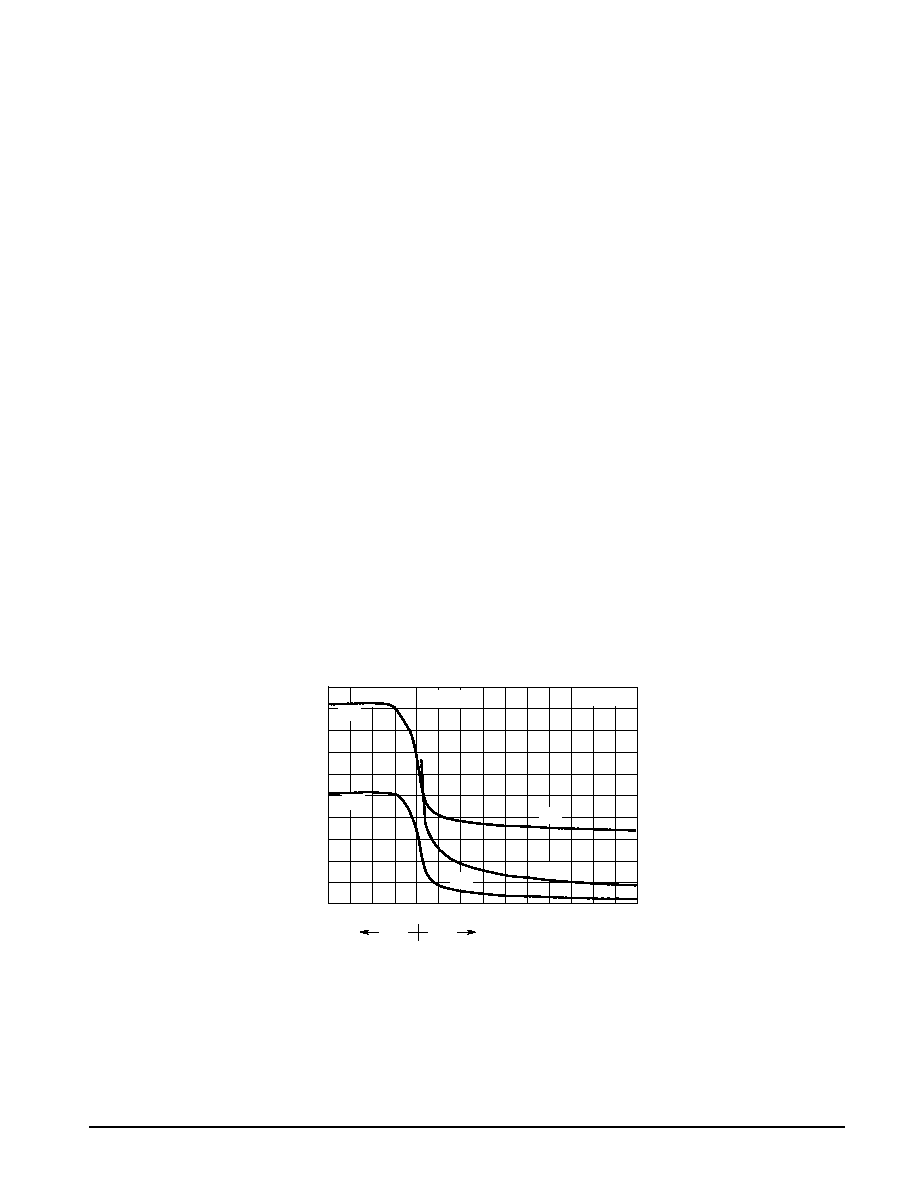
MTD20P06HDL
4
Motorola TMOS Power MOSFET Transistor Device Data
POWER MOSFET SWITCHING
Switching behavior is most easily modeled and predicted
by recognizing that the power MOSFET is charge controlled.
The lengths of various switching intervals (
t) are deter-
mined by how fast the FET input capacitance can be charged
by current from the generator.
The published capacitance data is difficult to use for calculat-
ing rise and fall because drain≠gate capacitance varies
greatly with applied voltage. Accordingly, gate charge data is
used. In most cases, a satisfactory estimate of average input
current (IG(AV)) can be made from a rudimentary analysis of
the drive circuit so that
t = Q/IG(AV)
During the rise and fall time interval when switching a resis-
tive load, VGS remains virtually constant at a level known as
the plateau voltage, VSGP. Therefore, rise and fall times may
be approximated by the following:
tr = Q2 x RG/(VGG ≠ VGSP)
tf = Q2 x RG/VGSP
where
VGG = the gate drive voltage, which varies from zero to VGG
RG = the gate drive resistance
and Q2 and VGSP are read from the gate charge curve.
During the turn≠on and turn≠off delay times, gate current is
not constant. The simplest calculation uses appropriate val-
ues from the capacitance curves in a standard equation for
voltage change in an RC network. The equations are:
td(on) = RG Ciss In [VGG/(VGG ≠ VGSP)]
td(off) = RG Ciss In (VGG/VGSP)
The capacitance (Ciss) is read from the capacitance curve at
a voltage corresponding to the off≠state condition when cal-
culating td(on) and is read at a voltage corresponding to the
on≠state when calculating td(off).
At high switching speeds, parasitic circuit elements com-
plicate the analysis. The inductance of the MOSFET source
lead, inside the package and in the circuit wiring which is
common to both the drain and gate current paths, produces a
voltage at the source which reduces the gate drive current.
The voltage is determined by Ldi/dt, but since di/dt is a func-
tion of drain current, the mathematical solution is complex.
The MOSFET output capacitance also complicates the
mathematics. And finally, MOSFETs have finite internal gate
resistance which effectively adds to the resistance of the
driving source, but the internal resistance is difficult to mea-
sure and, consequently, is not specified.
The resistive switching time variation versus gate resis-
tance (Figure 9) shows how typical switching performance is
affected by the parasitic circuit elements. If the parasitics
were not present, the slope of the curves would maintain a
value of unity regardless of the switching speed. The circuit
used to obtain the data is constructed to minimize common
inductance in the drain and gate circuit loops and is believed
readily achievable with board mounted components. Most
power electronic loads are inductive; the data in the figure is
taken with a resistive load, which approximates an optimally
snubbed inductive load. Power MOSFETs may be safely op-
erated into an inductive load; however, snubbing reduces
switching losses.
GATE≠TO≠SOURCE OR DRAIN≠TO≠SOURCE VOLTAGE (Volts)
C, CAP
ACIT
ANCE (pF)
Figure 7. Capacitance Variation
10
0
10
15
20
25
2500
2000
500
0
VGS
VDS
1500
1000
5
5
VDS = 0 V
Ciss
Crss
VGS = 0 V
TJ = 25
∞
C
Ciss
Coss
Crss
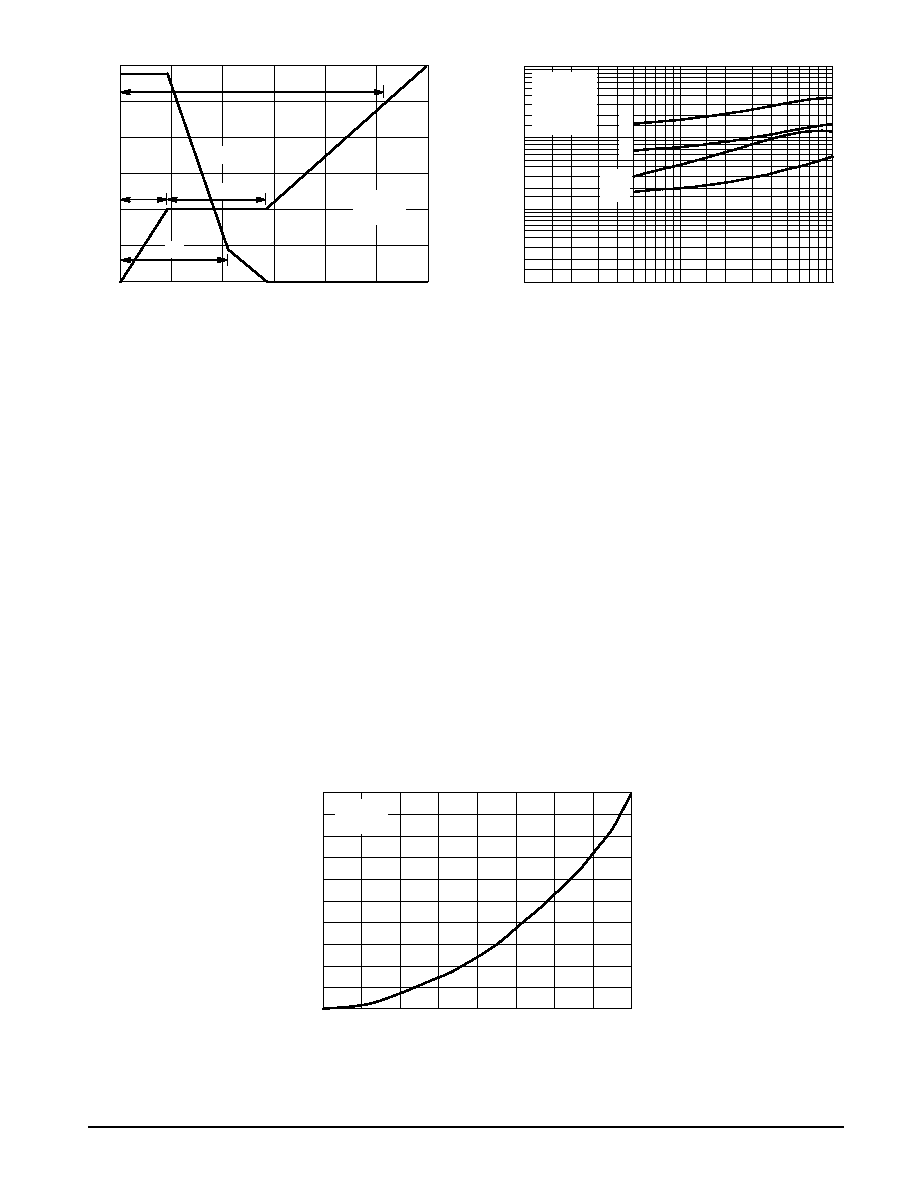
MTD20P06HDL
5
Motorola TMOS Power MOSFET Transistor Device Data
QG, TOTAL GATE CHARGE (nC)
RG, GATE RESISTANCE (Ohms)
t,
TIME (ns)
V
DS
, DRAIN≠T
O≠SOURCE VOL
T
AGE (VOL
TS)
V
GS
, GA
TE≠T
O≠SOURCE VOL
T
AGE (VOL
TS)
Figure 8. Gate≠To≠Source and Drain≠To≠Source
Voltage versus Total Charge
1
100
1000
1
100
VDD = 30 V
ID = 15 A
VGS = 5.0 V
TJ = 25
∞
C
tr
tf
td(on)
td(off)
Figure 9. Resistive Switching Time
Variation versus Gate Resistance
0
4
8
16
24
12
3
1
0
4
2
6
50
40
35
30
20
25
0
VGS
ID = 15 A
TJ = 25
∞
C
VDS
Q3
Q1
45
5
20
QT
Q2
10
10
15
10
5
DRAIN≠TO≠SOURCE DIODE CHARACTERISTICS
The switching characteristics of a MOSFET body diode
are very important in systems using it as a freewheeling or
commutating diode. Of particular interest are the reverse re-
covery characteristics which play a major role in determining
switching losses, radiated noise, EMI and RFI.
System switching losses are largely due to the nature of
the body diode itself. The body diode is a minority carrier de-
vice, therefore it has a finite reverse recovery time, trr, due to
the storage of minority carrier charge, QRR, as shown in the
typical reverse recovery wave form of Figure 12. It is this
stored charge that, when cleared from the diode, passes
through a potential and defines an energy loss. Obviously,
repeatedly forcing the diode through reverse recovery further
increases switching losses. Therefore, one would like a
diode with short trr and low QRR specifications to minimize
these losses.
The abruptness of diode reverse recovery effects the
amount of radiated noise, voltage spikes, and current ring-
ing. The mechanisms at work are finite irremovable circuit
parasitic inductances and capacitances acted upon by high
di/dts. The diode's negative di/dt during ta is directly con-
trolled by the device clearing the stored charge. However,
the positive di/dt during tb is an uncontrollable diode charac-
teristic and is usually the culprit that induces current ringing.
Therefore, when comparing diodes, the ratio of tb/ta serves
as a good indicator of recovery abruptness and thus gives a
comparative estimate of probable noise generated. A ratio of
1 is considered ideal and values less than 0.5 are considered
snappy.
Compared to Motorola standard cell density low voltage
MOSFETs, high cell density MOSFET diodes are faster
(shorter trr), have less stored charge and a softer reverse re-
covery characteristic. The softness advantage of the high
cell density diode means they can be forced through reverse
recovery at a higher di/dt than a standard cell MOSFET
diode without increasing the current ringing or the noise gen-
erated. In addition, power dissipation incurred from switching
the diode will be less due to the shorter recovery time and
lower switching losses.
I S
, SOURCE CURRENT
(AMPS)
VSD, SOURCE≠TO≠DRAIN VOLTAGE (Volts)
0.5
1.5
Figure 10. Diode Forward Voltage versus Current
1
VGS = 0 V
TJ = 25
∞
C
2.5
1.25
2
0.75
1.75
2.25
15
12
9
6
3
0
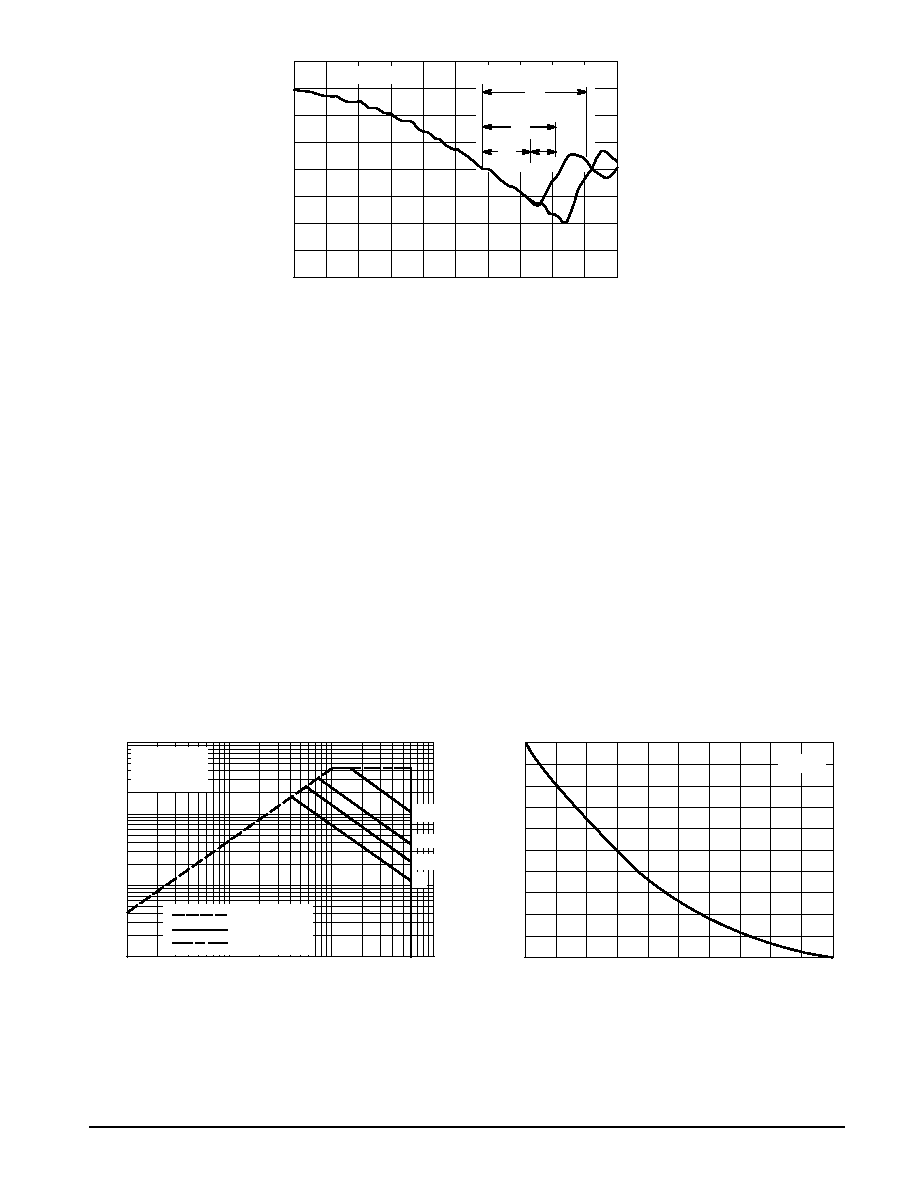
MTD20P06HDL
6
Motorola TMOS Power MOSFET Transistor Device Data
I S
, SOURCE CURRENT
t, TIME
Figure 11. Reverse Recovery Time (trr)
di/dt = 300 A/
µ
s
Standard Cell Density
High Cell Density
tb
trr
ta
trr
SAFE OPERATING AREA
The Forward Biased Safe Operating Area curves define
the maximum simultaneous drain≠to≠source voltage and
drain current that a transistor can handle safely when it is for-
ward biased. Curves are based upon maximum peak junc-
tion temperature and a case temperature (TC) of 25
∞
C. Peak
repetitive pulsed power limits are determined by using the
thermal response data in conjunction with the procedures
discussed in AN569, "Transient Thermal Resistance ≠ Gen-
eral Data and Its Use."
Switching between the off≠state and the on≠state may tra-
verse any load line provided neither rated peak current (IDM)
nor rated voltage (VDSS) is exceeded, and that the transition
time (tr, tf) does not exceed 10
µ
s. In addition the total power
averaged over a complete switching cycle must not exceed
(TJ(MAX) ≠ TC)/(R
JC).
A power MOSFET designated E≠FET can be safely used
in switching circuits with unclamped inductive loads. For reli-
able operation, the stored energy from circuit inductance dis-
sipated in the transistor while in avalanche must be less than
the rated limit and must be adjusted for operating conditions
differing from those specified. Although industry practice is to
rate in terms of energy, avalanche energy capability is not a
constant. The energy rating decreases non≠linearly with an
increase of peak current in avalanche and peak junction tem-
perature.
Although many E≠FETs can withstand the stress of drain≠
to≠source avalanche at currents up to rated pulsed current
(IDM), the energy rating is specified at rated continuous cur-
rent (ID), in accordance with industry custom. The energy rat-
ing must be derated for temperature as shown in the
accompanying graph (Figure 13). Maximum energy at cur-
rents below rated continuous ID can safely be assumed to
equal the values indicated.
VDS, DRAIN≠TO≠SOURCE VOLTAGE (VOLTS)
I D
, DRAIN CURRENT
(AMPS)
E
AS
, SINGLE PULSE DRAIN≠T
O≠SOURCE
A
V
ALANCHE ENERGY
(mJ)
TJ, STARTING JUNCTION TEMPERATURE (
∞
C)
Figure 12. Maximum Rated Forward Biased
Safe Operating Area
0
25
50
75
100
125
180
300
60
120
150
240
0.1
1.0
100
100
1.0
0.1
10
Figure 13. Maximum Avalanche Energy versus
Starting Junction Temperature
10
100
µ
s
1 ms
10 ms
ID = 15 A
VGS = 20 V
SINGLE PULSE
TC = 25
∞
C
RDS(on) LIMIT
THERMAL LIMIT
PACKAGE LIMIT
dc

MTD20P06HDL
7
Motorola TMOS Power MOSFET Transistor Device Data
TYPICAL ELECTRICAL CHARACTERISTICS
D = 0.5
0.05
0.01
SINGLE PULSE
R
JC(t) = r(t) R
JC
D CURVES APPLY FOR POWER
PULSE TRAIN SHOWN
READ TIME AT t1
TJ(pk) ≠ TC = P(pk) R
JC(t)
P(pk)
t1
t2
DUTY CYCLE, D = t1/t2
r(t)
, EFFECTIVE
TRANSIENT
THERMAL
RESIST
ANCE
(NORMALIZED)
0.1
1.0
0.01
Figure 14. Thermal Response
t, TIME (s)
Figure 15. Diode Reverse Recovery Waveform
di/dt
trr
ta
tp
IS
0.25 IS
TIME
IS
tb
1.0E≠05
1.0E≠04
1.0E≠03
1.0E≠02
1.0E≠01
1.0E+00
1.0E+01
0.1
0.02
0.2

MTD20P06HDL
8
Motorola TMOS Power MOSFET Transistor Device Data
INFORMATION FOR USING THE DPAK SURFACE MOUNT PACKAGE
RECOMMENDED FOOTPRINT FOR SURFACE MOUNTED APPLICATIONS
Surface mount board layout is a critical portion of the total
design. The footprint for the semiconductor packages must be
the correct size to ensure proper solder connection interface
between the board and the package. With the correct pad
geometry, the packages will self align when subjected to a
solder reflow process.
0.190
4.826
mm
inches
0.100
2.54
0.063
1.6
0.165
4.191
0.118
3.0
0.243
6.172
POWER DISSIPATION FOR A SURFACE MOUNT DEVICE
The power dissipation for a surface mount device is a
function of the drain pad size. These can vary from the
minimum pad size for soldering to a pad size given for
maximum power dissipation. Power dissipation for a surface
mount device is determined by TJ(max), the maximum rated
junction temperature of the die, R
JA, the thermal resistance
from the device junction to ambient, and the operating
temperature, TA. Using the values provided on the data sheet,
PD can be calculated as follows:
PD =
TJ(max) ≠ TA
R
JA
The values for the equation are found in the maximum
ratings table on the data sheet. Substituting these values into
the equation for an ambient temperature TA of 25
∞
C, one can
calculate the power dissipation of the device. For a DPAK
device, PD is calculated as follows.
PD =
150
∞
C ≠ 25
∞
C
71.4
∞
C/W
= 1.75 Watts
The 71.4
∞
C/W for the DPAK package assumes the use of
the recommended footprint on a glass epoxy printed circuit
board to achieve a power dissipation of 1.75 Watts. There are
other alternatives to achieving higher power dissipation from
the surface mount packages. One is to increase the area of the
drain pad. By increasing the area of the drain pad, the power
dissipation can be increased. Although one can almost double
the power dissipation with this method, one will be giving up
area on the printed circuit board which can defeat the purpose
of using surface mount technology. For example, a graph of
R
JA versus drain pad area is shown in Figure 16.
Figure 16. Thermal Resistance versus Drain Pad
Area for the DPAK Package (Typical)
1.75 Watts
Board Material = 0.0625
G≠10/FR≠4, 2 oz Copper
80
100
60
40
20
10
8
6
4
2
0
3.0 Watts
5.0 Watts
TA = 25
∞
C
A, AREA (SQUARE INCHES)
T
O
AMBIENT
(
C/W)
∞
R
JA
,
THERMAL
RESIST
ANCE, JUNCTION
Another alternative would be to use a ceramic substrate or
an aluminum core board such as Thermal Clad
TM
. Using a
board material such as Thermal Clad, an aluminum core
board, the power dissipation can be doubled using the same
footprint.

MTD20P06HDL
9
Motorola TMOS Power MOSFET Transistor Device Data
SOLDER STENCIL GUIDELINES
Prior to placing surface mount components onto a printed
circuit board, solder paste must be applied to the pads. Solder
stencils are used to screen the optimum amount. These
stencils are typically 0.008 inches thick and may be made of
brass or stainless steel. For packages such as the SC≠59,
SC≠70/SOT≠323, SOD≠123, SOT≠23, SOT≠143, SOT≠223,
SO≠8, SO≠14, SO≠16, and SMB/SMC diode packages, the
stencil opening should be the same as the pad size or a 1:1
registration. This is not the case with the DPAK and D2PAK
packages. If one uses a 1:1 opening to screen solder onto the
drain pad, misalignment and/or "tombstoning" may occur due
to an excess of solder. For these two packages, the opening
in the stencil for the paste should be approximately 50% of the
tab area. The opening for the leads is still a 1:1 registration.
Figure 17 shows a typical stencil for the DPAK and D2PAK
packages. The pattern of the opening in the stencil for the
drain pad is not critical as long as it allows approximately 50%
of the pad to be covered with paste.
«««
«««
«««
«««
«««
«««
«««
«««
«««
«««
«««
«««
«««
«««
«««
«««
«««
«««
««
««
««
««
««
««
««
««
««
««
««
««
Figure 17. Typical Stencil for DPAK and
D2PAK Packages
SOLDER PASTE
OPENINGS
STENCIL
SOLDERING PRECAUTIONS
The melting temperature of solder is higher than the rated
temperature of the device. When the entire device is heated
to a high temperature, failure to complete soldering within a
short time could result in device failure. Therefore, the
following items should always be observed in order to
minimize the thermal stress to which the devices are
subjected.
∑
Always preheat the device.
∑
The delta temperature between the preheat and soldering
should be 100
∞
C or less.*
∑
When preheating and soldering, the temperature of the
leads and the case must not exceed the maximum
temperature ratings as shown on the data sheet. When
using infrared heating with the reflow soldering method,
the difference shall be a maximum of 10
∞
C.
∑
The soldering temperature and time shall not exceed
260
∞
C for more than 10 seconds.
∑
When shifting from preheating to soldering, the maximum
temperature gradient shall be 5
∞
C or less.
∑
After soldering has been completed, the device should be
allowed to cool naturally for at least three minutes.
Gradual cooling should be used as the use of forced
cooling will increase the temperature gradient and result
in latent failure due to mechanical stress.
∑
Mechanical stress or shock should not be applied during
cooling.
* Soldering a device without preheating can cause excessive
thermal shock and stress which can result in damage to the
device.
* Due to shadowing and the inability to set the wave height to
incorporate other surface mount components, the D2PAK is
not recommended for wave soldering.

MTD20P06HDL
10
Motorola TMOS Power MOSFET Transistor Device Data
TYPICAL SOLDER HEATING PROFILE
For any given circuit board, there will be a group of control
settings that will give the desired heat pattern. The operator
must set temperatures for several heating zones, and a figure
for belt speed. Taken together, these control settings make up
a heating "profile" for that particular circuit board. On
machines controlled by a computer, the computer remembers
these profiles from one operating session to the next. Figure
18 shows a typical heating profile for use when soldering a
surface mount device to a printed circuit board. This profile will
vary among soldering systems but it is a good starting point.
Factors that can affect the profile include the type of soldering
system in use, density and types of components on the board,
type of solder used, and the type of board or substrate material
being used. This profile shows temperature versus time. The
line on the graph shows the actual temperature that might be
experienced on the surface of a test board at or near a central
solder joint. The two profiles are based on a high density and
a low density board. The Vitronics SMD310 convection/in-
frared reflow soldering system was used to generate this
profile. The type of solder used was 62/36/2 Tin Lead Silver
with a melting point between 177 ≠189
∞
C. When this type of
furnace is used for solder reflow work, the circuit boards and
solder joints tend to heat first. The components on the board
are then heated by conduction. The circuit board, because it
has a large surface area, absorbs the thermal energy more
efficiently, then distributes this energy to the components.
Because of this effect, the main body of a component may be
up to 30 degrees cooler than the adjacent solder joints.
STEP 1
PREHEAT
ZONE 1
"RAMP"
STEP 2
VENT
"SOAK"
STEP 3
HEATING
ZONES 2 & 5
"RAMP"
STEP 4
HEATING
ZONES 3 & 6
"SOAK"
STEP 5
HEATING
ZONES 4 & 7
"SPIKE"
STEP 6
VENT
STEP 7
COOLING
200
∞
C
150
∞
C
100
∞
C
50
∞
C
TIME (3 TO 7 MINUTES TOTAL)
TMAX
SOLDER IS LIQUID FOR
40 TO 80 SECONDS
(DEPENDING ON
MASS OF ASSEMBLY)
205
∞
TO 219
∞
C
PEAK AT
SOLDER JOINT
DESIRED CURVE FOR LOW
MASS ASSEMBLIES
100
∞
C
150
∞
C
160
∞
C
170
∞
C
140
∞
C
Figure 18. Typical Solder Heating Profile
DESIRED CURVE FOR HIGH
MASS ASSEMBLIES
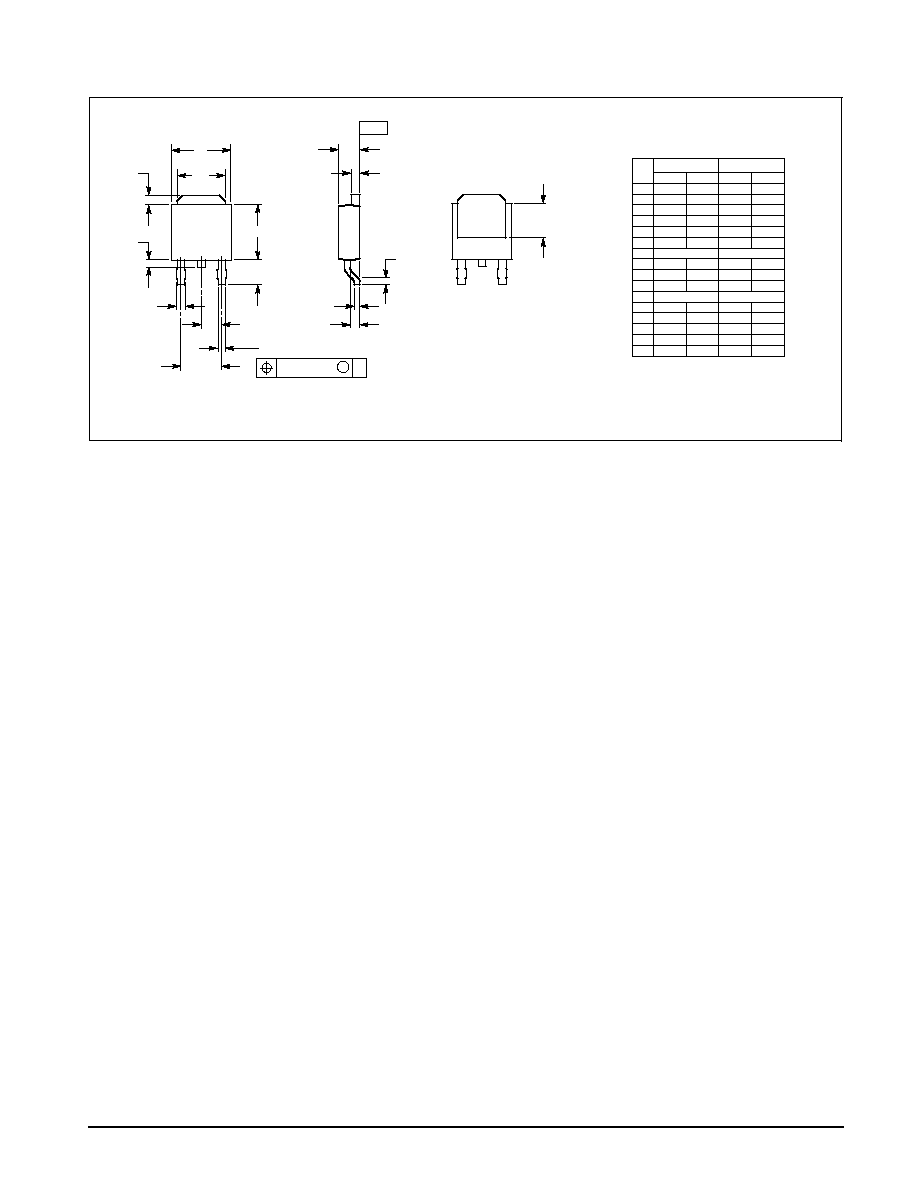
MTD20P06HDL
11
Motorola TMOS Power MOSFET Transistor Device Data
PACKAGE DIMENSIONS
CASE 369A≠13
ISSUE W
STYLE 2:
PIN 1. GATE
2. DRAIN
3. SOURCE
4. DRAIN
D
A
K
B
R
V
S
F
L
G
2 PL
M
0.13 (0.005)
T
E
C
U
J
H
≠T≠
SEATING
PLANE
Z
DIM
MIN
MAX
MIN
MAX
MILLIMETERS
INCHES
A
0.235
0.250
5.97
6.35
B
0.250
0.265
6.35
6.73
C
0.086
0.094
2.19
2.38
D
0.027
0.035
0.69
0.88
E
0.033
0.040
0.84
1.01
F
0.037
0.047
0.94
1.19
G
0.180 BSC
4.58 BSC
H
0.034
0.040
0.87
1.01
J
0.018
0.023
0.46
0.58
K
0.102
0.114
2.60
2.89
L
0.090 BSC
2.29 BSC
R
0.175
0.215
4.45
5.46
S
0.020
0.050
0.51
1.27
U
0.020
≠≠≠
0.51
≠≠≠
V
0.030
0.050
0.77
1.27
Z
0.138
≠≠≠
3.51
≠≠≠
NOTES:
1. DIMENSIONING AND TOLERANCING PER ANSI
Y14.5M, 1982.
2. CONTROLLING DIMENSION: INCH.

MTD20P06HDL
12
Motorola TMOS Power MOSFET Transistor Device Data
Motorola reserves the right to make changes without further notice to any products herein. Motorola makes no warranty, representation or guarantee regarding
the suitability of its products for any particular purpose, nor does Motorola assume any liability arising out of the application or use of any product or circuit,
and specifically disclaims any and all liability, including without limitation consequential or incidental damages. "Typical" parameters can and do vary in different
applications. All operating parameters, including "Typicals" must be validated for each customer application by customer's technical experts. Motorola does
not convey any license under its patent rights nor the rights of others. Motorola products are not designed, intended, or authorized for use as components in
systems intended for surgical implant into the body, or other applications intended to support or sustain life, or for any other application in which the failure of
the Motorola product could create a situation where personal injury or death may occur. Should Buyer purchase or use Motorola products for any such
unintended or unauthorized application, Buyer shall indemnify and hold Motorola and its officers, employees, subsidiaries, affiliates, and distributors harmless
against all claims, costs, damages, and expenses, and reasonable attorney fees arising out of, directly or indirectly, any claim of personal injury or death
associated with such unintended or unauthorized use, even if such claim alleges that Motorola was negligent regarding the design or manufacture of the part.
Motorola and
are registered trademarks of Motorola, Inc. Motorola, Inc. is an Equal Opportunity/Affirmative Action Employer.
How to reach us:
USA / EUROPE: Motorola Literature Distribution;
JAPAN: Nippon Motorola Ltd.; Tatsumi≠SPD≠JLDC, Toshikatsu Otsuki,
P.O. Box 20912; Phoenix, Arizona 85036. 1≠800≠441≠2447
6F Seibu≠Butsuryu≠Center, 3≠14≠2 Tatsumi Koto≠Ku, Tokyo 135, Japan. 03≠3521≠8315
MFAX: RMFAX0@email.sps.mot.com ≠ TOUCHTONE (602) 244≠6609
HONG KONG: Motorola Semiconductors H.K. Ltd.; 8B Tai Ping Industrial Park,
INTERNET: http://Design≠NET.com
51 Ting Kok Road, Tai Po, N.T., Hong Kong. 852≠26629298
MTD20P06HDL/D
*MTD20P06HDL/D*











